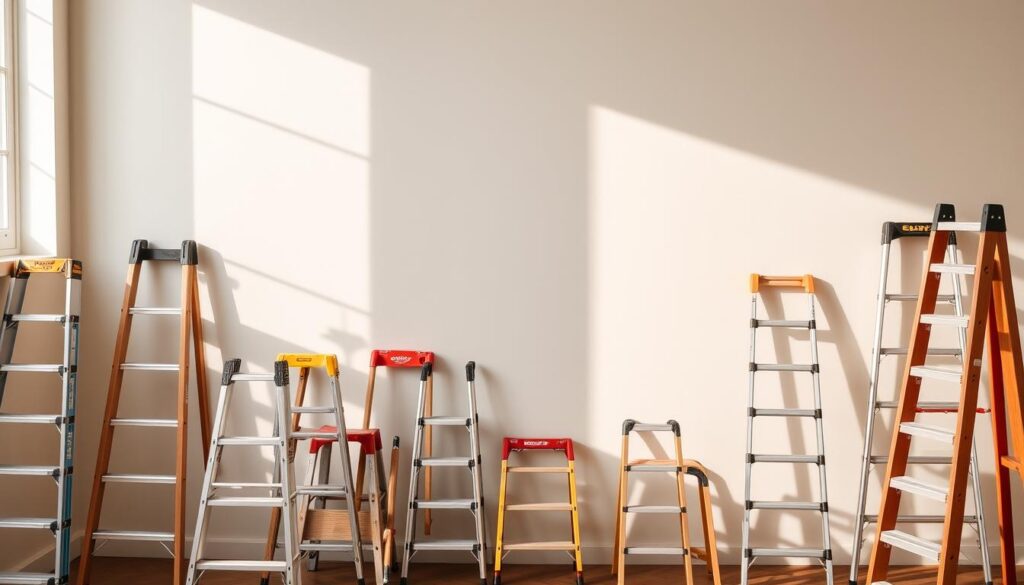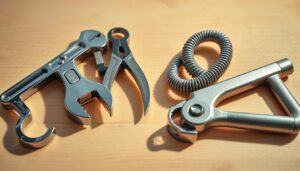Are you tired of struggling to find the right ladder for your home improvement tasks? With so many options available in the market, making an informed choice can be daunting. Our team has put together a comprehensive guide to help you navigate the vast array of household ladders on offer in 2025.
We’ll explore the latest innovations in ladder technology, safety features, and design improvements that have emerged this year. Whether you’re painting walls, cleaning gutters, or accessing high storage areas, our guide will help you discover the best ladder for your specific needs.
Key Takeaways
- Detailed comparisons of various ladder types, brands, and models
- Latest innovations in ladder technology and safety features
- Expert recommendations for choosing the right ladder for your home
- Price comparisons and performance reviews to inform your choice
- Tips for using ladders safely and effectively around your home
Understanding Your Ladder Needs
Whether you’re a homeowner or a DIY enthusiast, understanding your ladder needs is crucial for both safety and efficiency. To determine the right ladder for your tasks, you need to consider the types of projects you undertake and the specific requirements of each.
Assessing Your Home Projects
Before purchasing a ladder, you’ll need to assess the projects you typically undertake around your home. Consider the height you need to reach and the weight capacity required. For instance, if you’re changing light bulbs in the kitchen or accessing high storage in the garage, you’ll need a ladder that can safely support your weight and reach the desired height.
The variety of tasks you perform will influence your choice of ladder. From simple tasks like retrieving items from high shelves to more complex projects like painting or gutter cleaning, each task requires specific ladder features.
| Task Type | Height Requirement | Weight Capacity Needed |
|---|---|---|
| Changing light bulbs | Up to 3 meters | 100 kg |
| Gutter cleaning | Up to 6 meters | 150 kg |
| Painting eaves | Up to 5 meters | 120 kg |
Indoor vs Outdoor Requirements
Indoor projects often require different ladder specifications than outdoor tasks. Indoor ladders are typically more compact, lighter, and designed with non-marring feet to protect your floors. For outdoor requirements, you’ll need to consider weather resistance, stability on uneven ground, and potentially greater height capabilities.
Key considerations for outdoor ladders include:
- Weather-resistant materials
- Stability features for uneven ground
- Greater height capabilities for tasks like exterior painting or gutter cleaning
Types of Household Ladders Available in 2025
The 2025 market offers an extensive range of ladders for household use, catering to different requirements and preferences. As you navigate through the various options, you’ll find that each type of ladder is designed with specific applications in mind, ensuring that you can find the perfect fit for your home projects.
Stepladders
Stepladders remain a staple in many households, featuring an A-frame design that provides self-support. They are ideal for tasks that require moderate height access in open areas. Perfect for indoor use, stepladders are versatile and come in various heights to suit different needs.
Extension Ladders
Extension ladders have seen significant improvements in 2025, with advancements in materials and safety features. They are particularly useful for reaching high exterior areas such as roofs and gutters. Lighter and more durable, extension ladders are a valuable addition to any homeowner’s toolkit.
Telescoping Ladders
Telescoping ladders are gaining popularity due to their compact storage capabilities and versatility. They extend segment by segment to your desired height and collapse down to a fraction of their extended size, making them ideal for homes with limited storage space.
Multi-Position Ladders
Multi-position ladders, such as those from Little Giant, offer remarkable versatility with their ability to transform into different configurations. They can be used as A-frames, extension ladders, or in 90-degree positions, making them highly adaptable for various tasks around the home.
For complete ladder coverage for a two-story home, inside and out, it is recommended to own both a stepladder and a larger, extension ladder. This combination ensures that you’re well-equipped to handle any task that requires reaching high areas.
The variety of materials used in modern ladders includes lightweight aluminium for easy transport, durable fiberglass for electrical safety, and innovative composite materials that combine strength with reduced weight. As you choose your ladder, consider the specific needs of your projects and the benefits of each material type.
Key Features to Consider When Choosing a Ladder
The process of picking the ideal ladder requires careful consideration of various critical features that affect its usability and safety. When evaluating ladders, several key factors come into play to ensure you select the most appropriate one for your needs.
Height and Reach Capabilities
When selecting a ladder, height and reach capabilities are crucial considerations. You need to determine the maximum height you’ll need to reach and then choose a ladder that extends at least 3 feet beyond that point for safety. As Larry Campbell, a licensed electrical contractor, advises, “Your stepladder should be tall enough so that you never need to stand with your knee higher than the top of the ladder.”
Weight Capacity and Duty Ratings
Weight capacity and duty ratings indicate how much weight a ladder can safely support. These ratings range from Type III (200 pounds) to Type IAA (375 pounds), so you’ll need to consider your own weight plus any tools and materials you’ll be using. For instance, if you weigh 150 pounds and often carry 30 pounds of tools, you’ll need a ladder with a duty rating that can support at least 180 pounds.
| Duty Rating | Weight Capacity |
|---|---|
| Type III | 200 pounds |
| Type II | 225 pounds |
| Type I | 250 pounds |
| Type IA | 300 pounds |
| Type IAA | 375 pounds |
Material Considerations
The material of the ladder impacts not only its weight but also its application. Aluminium ladders are lightweight but conduct electricity, making them less suitable for electrical work. On the other hand, fiberglass ladders are heavier but safer around electrical tasks due to their non-conductive properties.
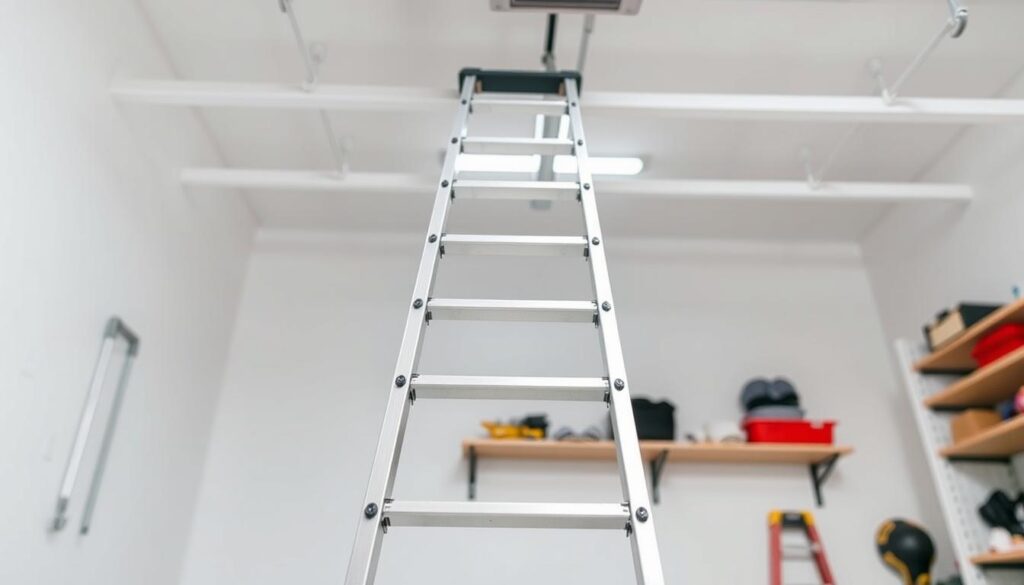
Stability Features
Stability features such as wide bases, non-slip feet, and stabilising bars can significantly improve safety, especially when working on uneven ground or at greater heights. These features help prevent the ladder from slipping or shifting while in use, providing a more stable working environment.
“Additional features to consider include tool trays or holders, which keep necessary tools within reach and reduce the need to climb up and down repeatedly,” says industry experts.
By carefully evaluating these key features, you can select a ladder that meets your specific needs, ensuring both safety and efficiency in your work.
Comprehensive Household Ladders Comparison 2025
In our comprehensive comparison of household ladders for 2025, we’ll examine the key factors that set them apart. As you navigate the numerous options available, understanding these differences is crucial for making an informed decision.
Weight and Portability
When it comes to household ladders, weight and portability are significant considerations. Aluminium ladders typically weigh between 15-20 pounds, making them easier to manoeuvre, while fiberglass options can be substantially heavier, often exceeding 30 pounds for the same height. This variation in weight can significantly impact your ability to move the ladder around your home or store it in a compact space.
- Aluminium ladders are generally lighter and more portable.
- Fiberglass ladders, though heavier, offer other benefits such as durability and resistance to electrical conductivity.
Storage Solutions and Space Requirements
The design of modern household ladders has evolved to address storage solutions and space constraints. Many models now feature innovative designs that allow for compact storage. For instance, some ladders fold to just 1.6 inches in thickness, while telescoping models collapse to less than 3 feet in height, making them ideal for homes with limited storage space.
Price Range Analysis
The price range for quality household ladders in 2025 varies significantly, from £70 for basic stepladders to over £300 for advanced multi-position or professional-grade extension ladders. For most homeowners, the sweet spot lies between £100-£150, offering a balance between quality and affordability.
- Basic stepladders start at around £70.
- Advanced multi-position ladders can cost over £300.
- The optimal price range for most homeowners is £100-£150.
Durability and Longevity
Durability is another critical factor in the comparison of household ladders. Fiberglass ladders have been found to outlast aluminium models by 3-5 years under similar use conditions, although they come with a 20-30% price premium. The choice between these materials depends on your priorities regarding longevity and budget.
When comparing extension ladders, stability when fully extended varies significantly between brands. Models featuring D-shaped rungs and wider bases provide superior stability at height, enhancing safety during use.
- Fiberglass ladders are more durable and longer-lasting.
- Extension ladders with D-shaped rungs offer better stability.
Best Stepladders for Home Use
For homeowners in the UK, selecting the best stepladder is crucial for safety and efficiency. A good stepladder provides the necessary support and stability for various home projects, ensuring that you can work comfortably and safely.
Dewalt 4-foot Fiberglass Step Ladder
The Dewalt 4-foot Fiberglass Step Ladder is exceptionally stable, with a wide base and sturdy feet, providing an 8.5-foot reach height ideal for most indoor household tasks. Weighing just under 15 pounds, it is remarkably lightweight for a fiberglass ladder, making it easy to move between rooms while offering electrical safety.

Gorilla GLX-5B 5.5 ft. Aluminum Dual Platform Ladder
The Gorilla GLX-5B stands out with its innovative dual platform design, featuring top two steps that are significantly wider (8.5 inches deep) to support your entire foot for improved balance. With a 300 pounds weight capacity, it comfortably supports users along with tools and materials, and its built-in project tray provides convenient storage.
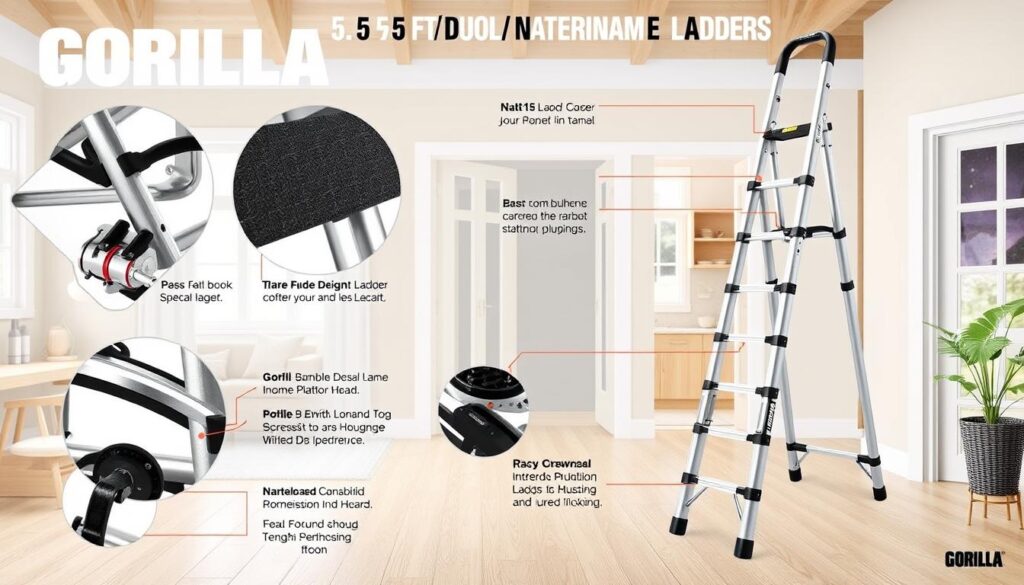
HBTower 5-Foot Wide-Step Folding Step Ladder
The HBTower 5-Foot Wide-Step Folding Step Ladder features 8.3-inch deep plastic rungs that accommodate larger foot sizes comfortably, with rubber feet that prevent slipping even on slightly uneven surfaces. It also includes a detachable tool bag with multiple pockets, perfect for organizing smaller items during project work.
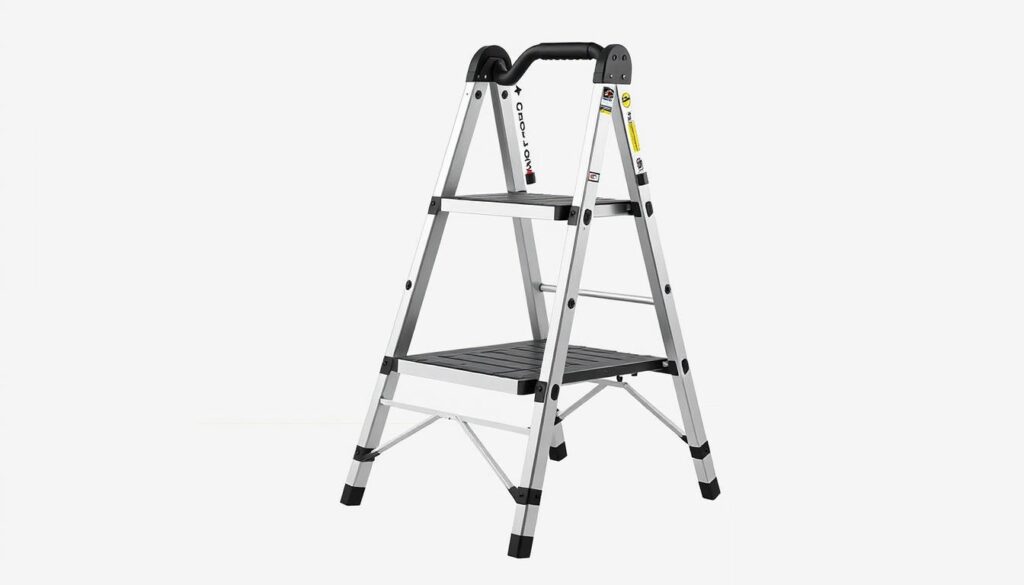
Top Platform Stepladders
The right platform stepladder can make all the difference in your home projects, offering both safety and convenience. When working at heights, having a stable and comfortable standing area is crucial. Platform stepladders are designed to provide this, with a wider top step that allows you to stand comfortably with both feet, reducing fatigue during extended use.
Cosco 6-Foot Platform Stepladder
The Cosco 6-Foot Platform Stepladder is a standout for its exceptionally large platform, measuring 13.5 inches deep. This provides ample space for both feet, improving balance while working at height. The extended frame design rises 24 inches above the platform, offering excellent stability and a secure handhold when needed. Despite its robust construction, the Cosco ladder weighs just 17.6 pounds, making it manageable for most users to carry.
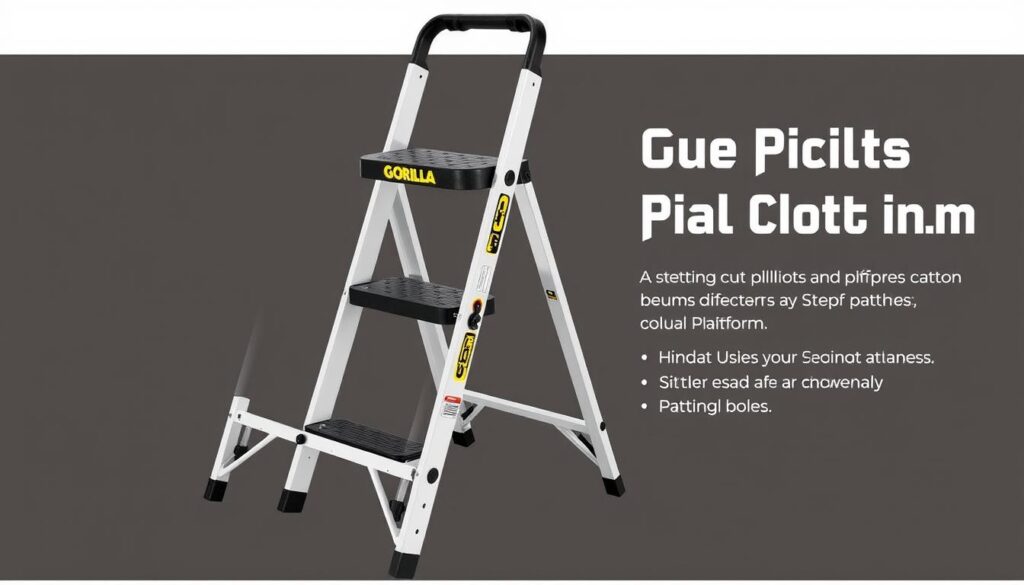
Gorilla GLXF-5B 5.5 ft. Fiberglass Dual Platform Step Ladder
The Gorilla GLXF-5B 5.5 ft. Fiberglass Dual Platform Step Ladder offers similar features to its aluminium counterpart but with the added benefit of electrical safety due to its non-conductive fiberglass rails. Both ladders feature slip-resistant feet and steps, with the Gorilla model’s dual platform design providing two wide steps at the top rather than just one, allowing for more flexible positioning while working.
Platform stepladders like these models represent a significant advancement in ladder design. They are ideal for home projects, offering the stability and comfort needed for tasks that require standing for extended periods. Whether you’re working on a DIY project or need a reliable ladder for household chores, these top platform stepladders are worth considering.
Best Ladders with Enhanced Safety Features
Ladder safety has taken a leap forward with the introduction of sophisticated safety features in modern ladders. As a homeowner, you’re likely to appreciate the advancements made in ladder design to minimise risks, particularly for elderly users or those working on uneven ground.
HBTower 3-Step Ladder with Handrails
The HBTower 3-Step Ladder is a prime example of a ladder that prioritises safety without compromising on functionality. It features cushioned handrails on both sides and at the top, providing maximum stability and security. The ladder’s 8.3-inch deep heavy-duty plastic rungs offer excellent foot support, while its steel frame construction ensures durability without excessive weight.
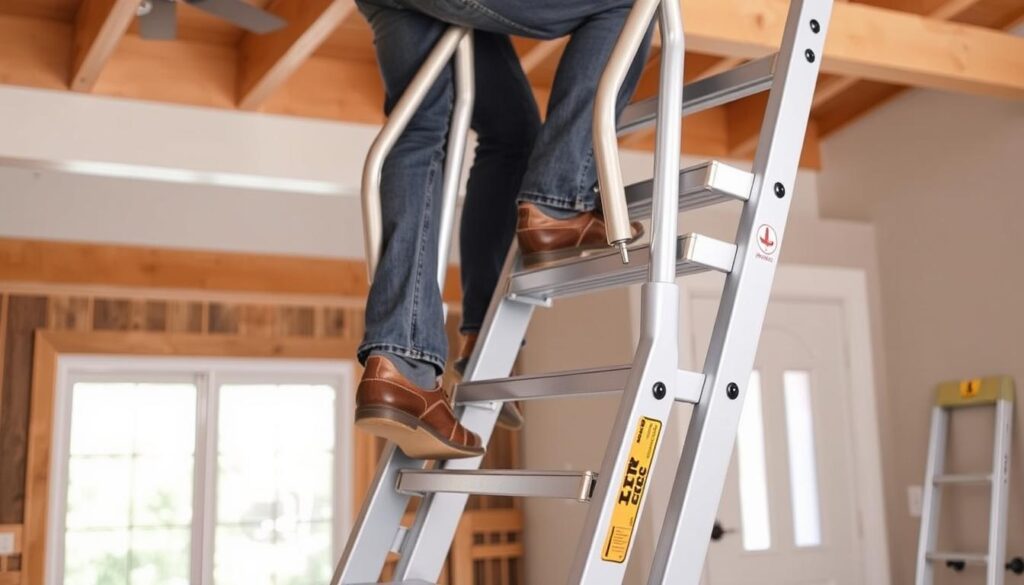
Werner FS106 6ft Type I Fiberglass Single Sided Step Ladder
For those seeking a ladder that excels in electrical safety, the Werner FS106 6ft Type I Fiberglass Single Sided Step Ladder is an excellent choice. Its non-conductive fiberglass construction makes it ideal for work near electrical fixtures or wiring. Additionally, the ladder includes a detachable tool bag with multiple pockets, allowing you to keep necessary tools within reach.
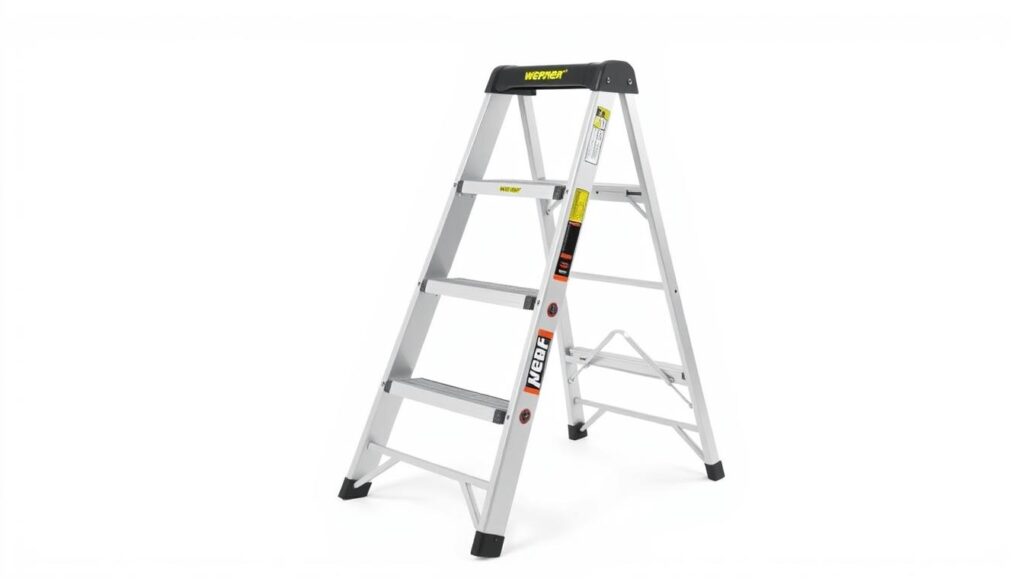
Both the HBTower and Werner ladders feature advanced safety mechanisms, including anti-slip feet designs that increase grip when pressure is applied, preventing the ladder from sliding on smooth surfaces. Their locking mechanisms have been tested to exceed industry safety standards, ensuring the ladder remains securely opened during use.
When choosing a ladder, it’s essential to consider the specific safety features that matter most to you. Whether it’s the added stability of handrails or the electrical safety of fiberglass construction, there’s a ladder designed to meet your needs.
Top Extension Ladders for Outdoor Projects
For outdoor tasks that demand extra height, selecting the appropriate extension ladder is crucial for safety and efficiency. Extension ladders are essential for projects requiring significant height, offering exceptional stability even when fully extended.
Werner D6228-2 28ft Type IA Fiberglass D-Rung Extension Ladder
The Werner D6228-2 stands out for its impressive 28-foot reach, making it suitable for accessing the roof of a typical two-story house safely. With a load capacity of 300 pounds, it can comfortably support a worker along with tools and materials. The D-shaped rungs provide better foot support than traditional round rungs.
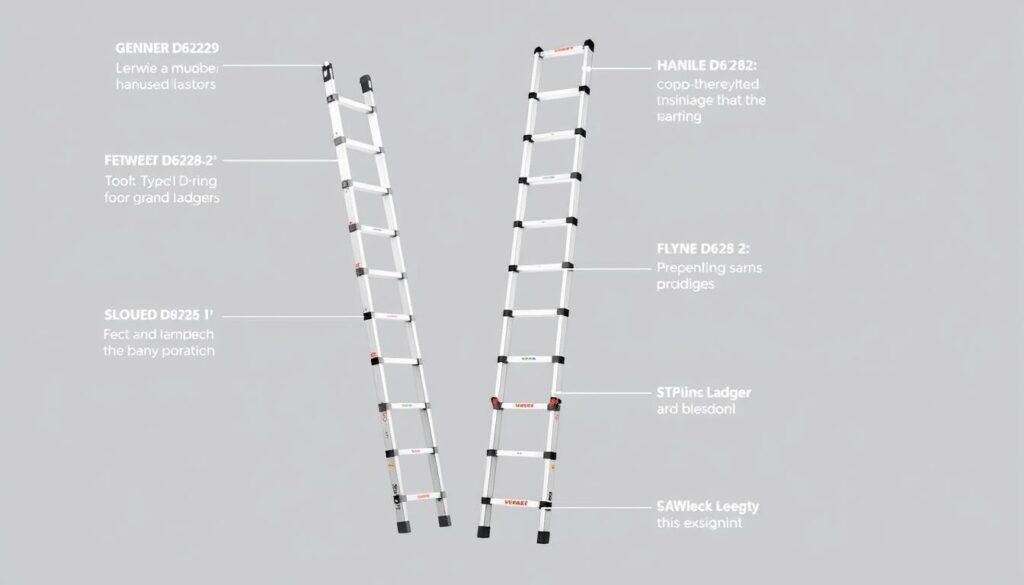
Louisville 16-foot Fiberglass Extension Ladder
The Louisville 16-foot Fiberglass Extension Ladder features innovative swivel safety feet that can be positioned in different angles to compensate for uneven surfaces, enhancing stability. Both the Werner and Louisville ladders include mar-resistant end caps to prevent damage to surfaces they rest against.
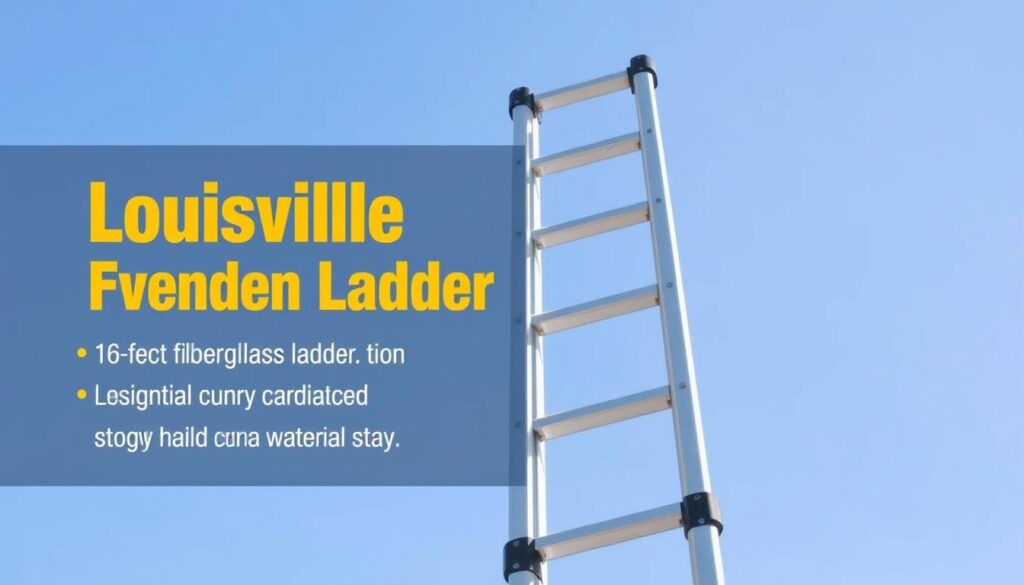
Our testing revealed that the Werner ladder’s fiberglass construction offers superior durability in outdoor conditions compared to aluminium models, with the added benefit of being non-conductive around power lines. The rope and pulley extension system on these ladders has been refined in 2025 models, requiring less effort to extend while maintaining secure locking when deployed.
When choosing an extension ladder, consider the height and weight capacity to ensure it meets your project’s requirements. The design and material of the ladder are also crucial for durability and safety.
Best Telescoping Ladders for Easy Storage
For those seeking a ladder that combines functionality with ease of storage, telescoping ladders are an excellent choice. These ladders are designed to be compact, making them ideal for homes with limited space.
Telescoping ladders have revolutionised ladder storage, with our top picks collapsing to as little as 33 x 19 inches while extending to heights of 12.5 feet or more when fully deployed. This versatility makes them perfect for a variety of tasks, from household chores to professional projects.
ARCHOM Telescopic Ladder
The ARCHOM Telescopic Ladder features an innovative segment-by-segment extension system, allowing you to customise the ladder’s height in 12-inch increments. With a weight of just 27 pounds and a load capacity of 330 pounds, this ladder offers an excellent strength-to-weight ratio, making it both portable and sturdy.
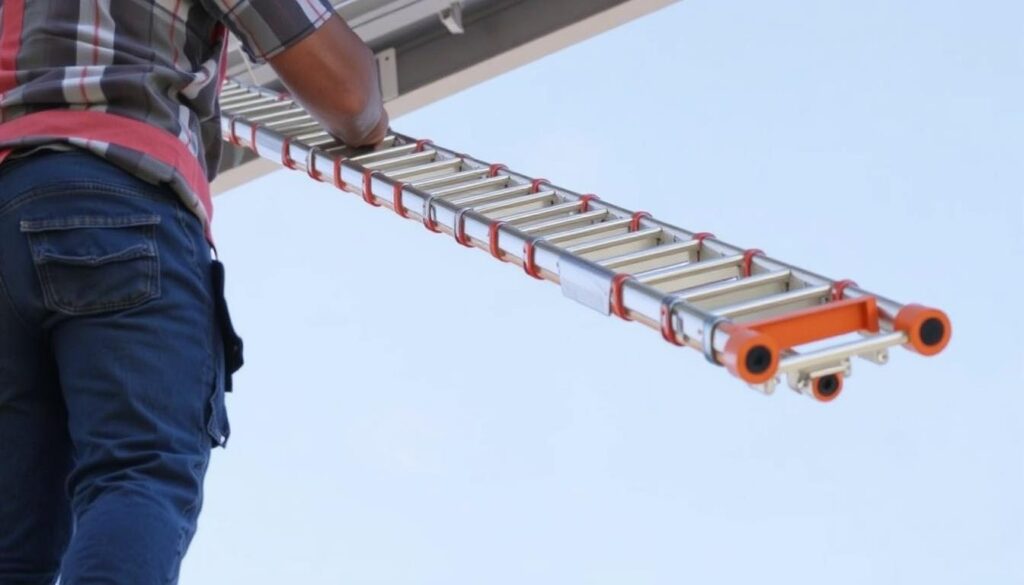
One of the standout features of the ARCHOM Telescopic Ladder is its one-touch retraction system, which enables smooth, controlled collapse without pinch points. This design consideration significantly enhances user safety.
Soctone Telescoping Ladder
The Soctone Telescoping Ladder includes triangle stabilisers at its base, significantly improving stability compared to earlier telescoping ladder designs. This feature addresses a common concern with telescoping ladders, providing users with added confidence when climbing.
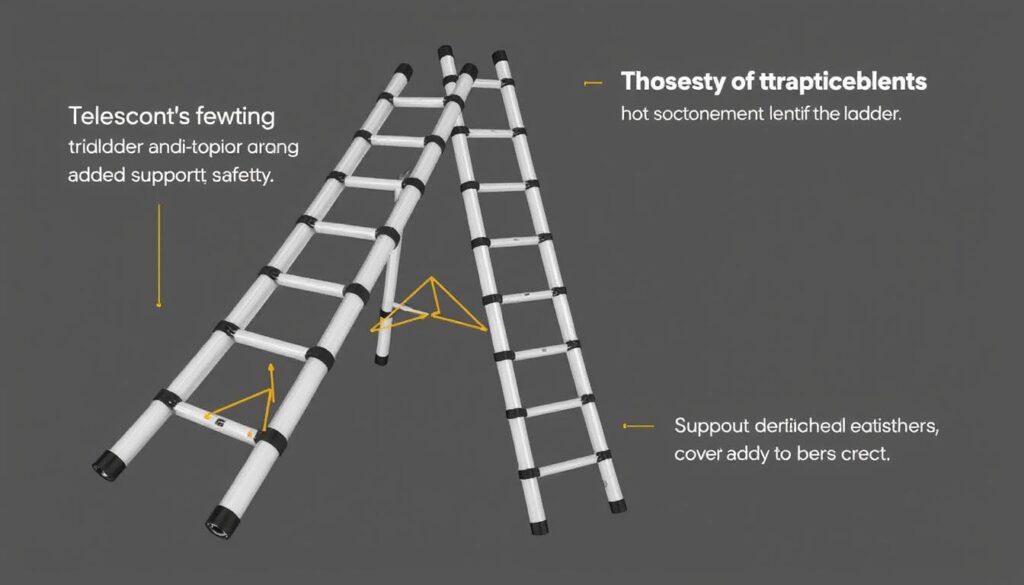
Both the ARCHOM and Soctone Telescoping Ladders feature improved locking mechanisms, ensuring each section remains securely in place during use. Storage considerations are also paramount with these ladders, as they can be tucked into small spaces, making them ideal for flats, small homes, or anywhere with limited storage space.
In conclusion, telescoping ladders offer a practical solution for those requiring a versatile, space-saving ladder. With their compact design, improved safety features, and robust construction, models like the ARCHOM and Soctone Telescoping Ladders are excellent choices for both household and professional use.
Multi-Position Ladders for Maximum Versatility
For those seeking versatility in their ladder, multi-position ladders are the ultimate solution. These ladders can transform into various configurations, making them ideal for a wide range of tasks and environments.
Little Giant M17 Velocity Multi-Position Ladder
The Little Giant M17 Velocity is a highly versatile multi-position ladder, capable of transforming into stepladders, extension ladders, 90-degree ladders, and staircase ladders. With an impressive 18.1-foot maximum reach height when configured as an extension ladder, it maintains a reasonable storage footprint when collapsed.
Weighing 35 pounds with a load capacity of 300 pounds, the M17 Velocity balances portability with strength. Although it is heavier than single-purpose ladders of similar height, its versatility justifies the additional weight.
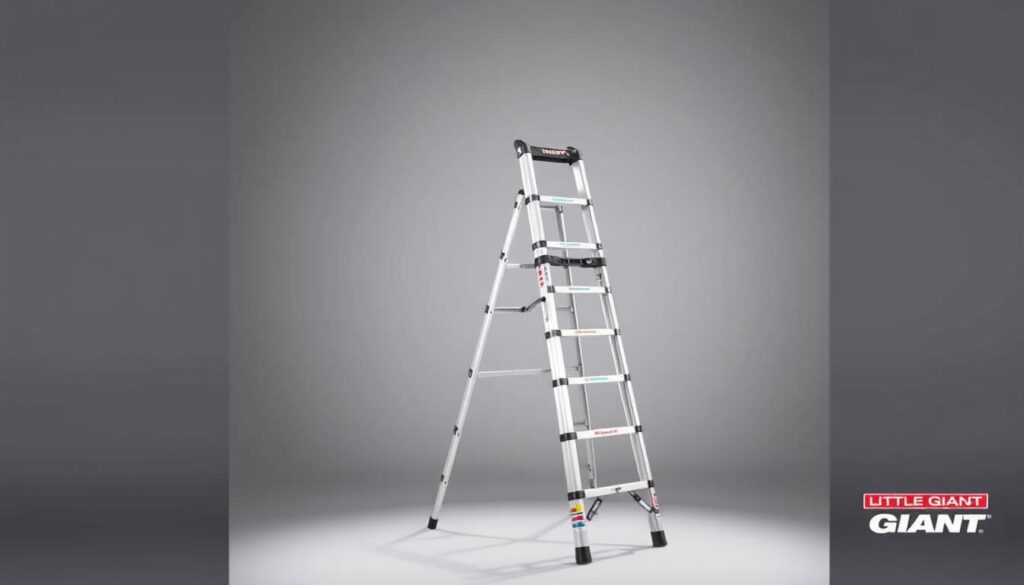
Little Giant Select Step Model 5-8
The Little Giant Select Step Model 5-8 offers unique adjustability, with legs that can telescope to different lengths, allowing for safe positioning on uneven ground or stairs. This feature makes it ideal for use on sloped driveways, staircases, or uneven terrain.
The ladder also includes an innovative tool tray that converts into a handhold when positioned vertically, enhancing safety while maintaining functionality. The refined locking mechanisms in the 2025 models provide audible clicks, confirming secure engagement and reducing the risk of improper setup.
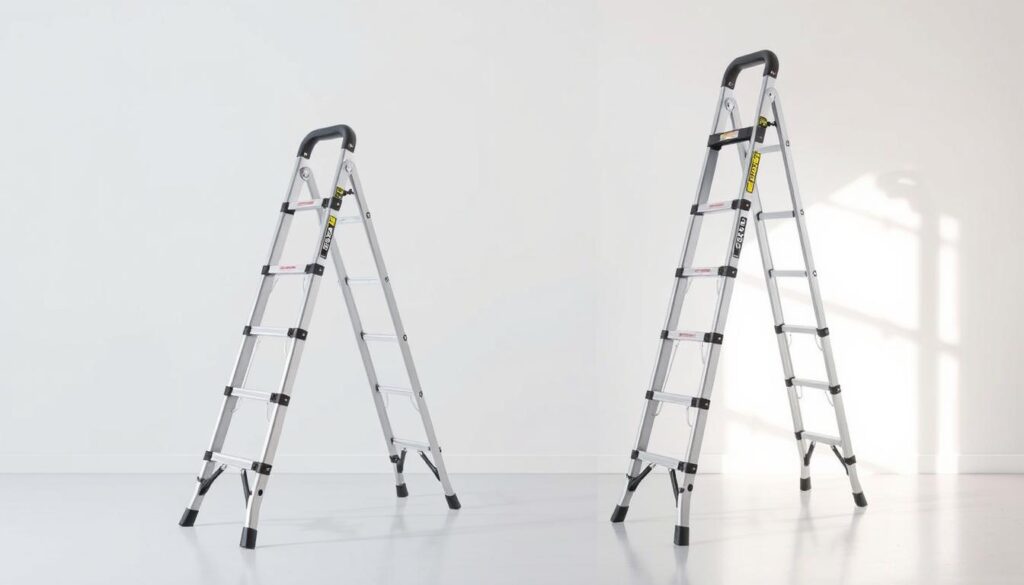
Aluminium vs Fiberglass Ladders: Which to Choose
When it comes to choosing the right ladder for your household needs, the debate between aluminium and fiberglass ladders is a crucial one. Your decision will significantly impact the safety, efficiency, and overall success of your home projects.
Benefits of Aluminium Ladders
Aluminium ladders are known for their lightweight nature, making them an excellent choice for outdoor projects such as painting and cleaning gutters. They are typically 30-40% lighter than their fiberglass counterparts, which makes them easier to transport and maneuver around your property. This portability is particularly beneficial for extension ladders and telescoping ladders where weight significantly impacts usability.
Advantages of Fiberglass Ladders
Fiberglass ladders, on the other hand, offer superior electrical insulation properties, making them the safest choice for electrical work. They are ideal for tasks that involve working near power lines or electrical systems. While they tend to be heavier than aluminium ladders, fiberglass step ladders are generally more stable and less prone to denting or bending, potentially offering a longer service life under heavy use conditions.
Best Applications for Each Material
The choice between aluminium and fiberglass ultimately depends on your specific needs. For outdoor projects that require frequent moving around, aluminium ladders might be the better choice. For tasks involving electrical systems or requiring enhanced stability, fiberglass ladders are preferable. It’s worth noting that manufacturers like Little Giant offer both aluminium and fiberglass versions of their multi-position ladders, allowing you to select the material that best suits your primary use case.
| Material | Weight | Electrical Insulation | Best Use |
|---|---|---|---|
| Aluminium | Lightweight | No | Outdoor projects, extension ladders |
| Fiberglass | Heavier | Yes | Electrical work, stable step ladders |
Understanding Ladder Specifications and Standards
Comprehending ladder specifications and safety standards is vital for preventing accidents. When choosing a ladder, it’s crucial to understand the various specifications and standards that govern their safety and performance.
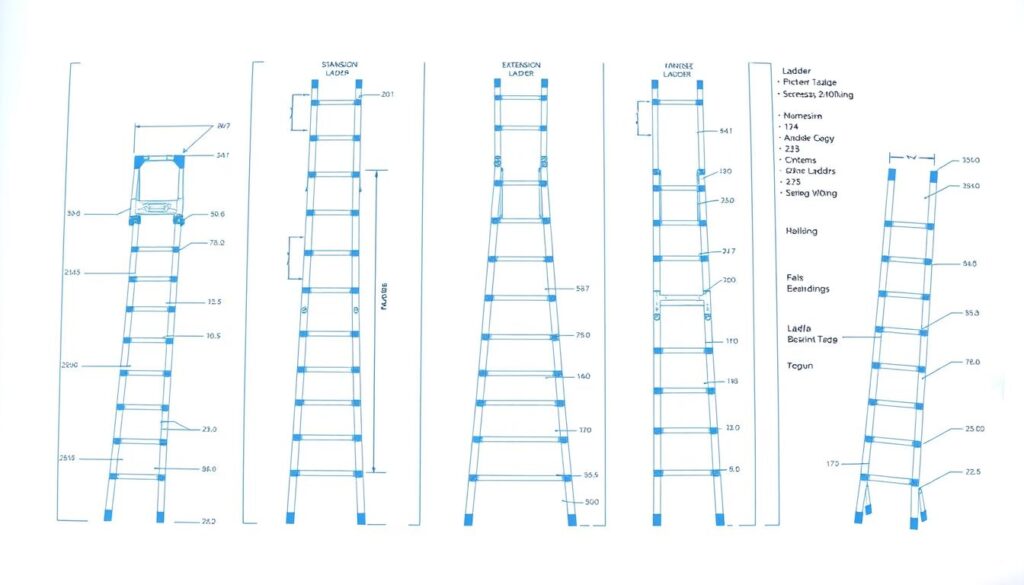
Decoding Duty Ratings and Weight Capacities
Ladder duty ratings are categorised based on their weight capacity, ranging from Type III (light duty, 200 pounds) to Type IAA (extra heavy duty, 375 pounds). The load capacity rating includes your body weight plus any tools, materials, or equipment you’ll be carrying. For instance, premium manufacturers like Little Giant often exceed the minimum safety requirements, with many ladders rated for 300 pounds or more.
| Duty Rating | Weight Capacity (pounds) |
|---|---|
| Type III | 200 |
| Type II | 225 |
| Type I | 250 |
| Type IA | 300 |
| Type IAA | 375 |
British and European Safety Standards
British and European safety standards for ladders are governed by EN131, which was updated in 2019 to create two distinct categories: Professional (for industrial and trade use) and Non-Professional (for domestic use). Understanding these standards is essential for selecting a ladder that meets your needs and ensures safety.
When selecting a ladder, consider both the duty rating and the safety standards it adheres to. This ensures that your ladder is suitable for its intended use and provides the necessary safety features.
Specialised Ladders for Specific Tasks
When it comes to specific tasks, using the right ladder can make all the difference in terms of safety and efficiency. Specialised ladders are designed to tackle particular jobs, providing the necessary support and stability to get the task done.
Loft Ladders and Attic Access
Loft ladders are a great example of specialised ladders. They offer convenient access to attic spaces without taking up valuable storage space when not in use. Modern loft ladders come in a variety of styles, including telescoping, folding, and concertina designs. Some even feature insulated hatches to improve home energy efficiency.
| Ladder Type | Key Features | Benefits |
|---|---|---|
| Telescoping Loft Ladder | Compact design, easy to install | Saves storage space, convenient access |
| Folding Loft Ladder | Space-saving, sturdy construction | Ideal for small homes, durable |
| Concertina Loft Ladder | Easy to use, compact storage | Convenient, saves space |
Decorating and Painting Ladders
Decorating and painting ladders often include features specifically designed to make these tasks easier. For example, some ladders come with paint tray holders, tool hooks, and wider platforms for greater stability while reaching. Platform ladders with large standing areas are ideal for tasks requiring extended periods at height, such as kitchen renovations or garage organisation.
Articulated ladders that can be positioned in multiple configurations are particularly useful for decorating stairwells or working in tight spaces where conventional ladders won’t fit. The height and reach requirements for specialised tasks vary significantly – while changing a light bulb might require only a 4-foot step ladder, cleaning gutters typically requires an extension ladder of at least 16 feet.
Budget Considerations and Value for Money
Understanding your budget is essential before making a ladder purchase. Your budget considerations will significantly influence the type of ladder you can buy, and it’s crucial to balance the initial cost against the durability, versatility, and safety features to determine the true value for money over the ladder’s lifetime.
Entry-Level Options
Entry-level step ladders typically start around £50-£70, offering adequate functionality for occasional light use. These budget-friendly options often lack the durability and features of mid-range ladders. When choosing an entry-level ladder, consider the storage space you have available and look for models with compact folding designs that offer easy store capabilities.
Premium Ladder Investments
Premium ladder investments (£200-£350) make sense for frequent users or those requiring specialised features. These ladders often offer significantly improved stability, weight capacity, and useful features like tool trays or wide steps. When evaluating premium ladder options, consider the space you have available for storage and the long-term value the ladder will provide.
| Ladder Type | Price Range | Key Features |
|---|---|---|
| Entry-Level Step Ladder | £50-£70 | Basic functionality, compact design |
| Mid-Range Ladder | £100-£200 | Improved stability, weight capacity, additional features |
| Premium Ladder | £200-£350 | High durability, specialised features, exceptional versatility |
When making your choice, consider your specific needs and how they align with the price and features of the ladder. By doing so, you’ll ensure that your ladder purchase provides the best value for money.
Conclusion
In the realm of household maintenance, having the right ladder is not just a convenience, it’s a necessity. Selecting the ideal ladder for your household needs requires careful consideration of multiple factors, including height requirements, weight capacity, material, stability features, and storage constraints.
For most homes, a combination of a quality step ladder for indoor use and an extension ladder for outdoor tasks provides the versatility needed. Safety should always be your primary consideration when selecting and using any ladder, with proper weight ratings and stable design taking precedence over price or convenience factors.
Remember, investing in a higher-quality ladder initially often proves more economical in the long run. Proper storage and maintenance will significantly extend its useful life. Whatever your choice, always follow manufacturer guidelines and safety best practices when using any ladder in or around your home.
